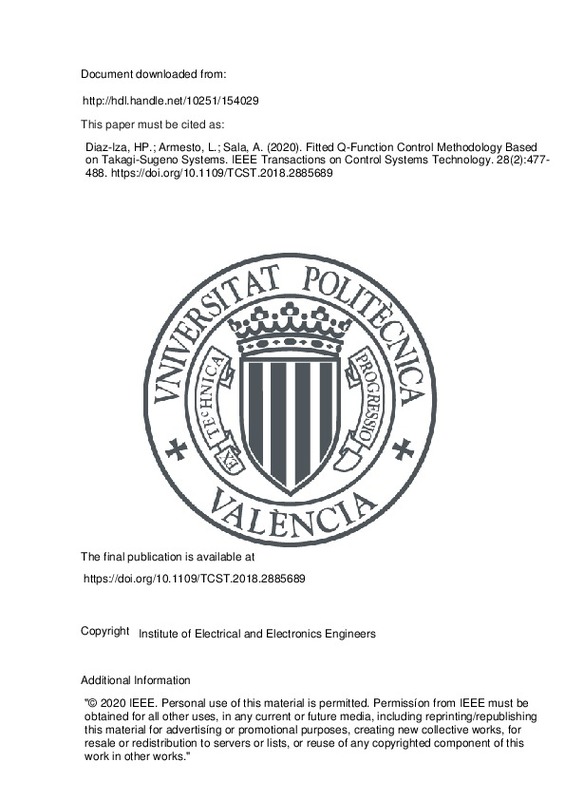JavaScript is disabled for your browser. Some features of this site may not work without it.
Buscar en RiuNet
Listar
Mi cuenta
Estadísticas
Ayuda RiuNet
Admin. UPV
Fitted Q-Function Control Methodology Based on Takagi-Sugeno Systems
Mostrar el registro sencillo del ítem
Ficheros en el ítem
| dc.contributor.author | Diaz-Iza, Henry Paul
|
es_ES |
| dc.contributor.author | Armesto, Leopoldo
|
es_ES |
| dc.contributor.author | Sala, Antonio
|
es_ES |
| dc.date.accessioned | 2020-11-04T04:32:17Z | |
| dc.date.available | 2020-11-04T04:32:17Z | |
| dc.date.issued | 2020-03 | es_ES |
| dc.identifier.issn | 1063-6536 | es_ES |
| dc.identifier.uri | http://hdl.handle.net/10251/154029 | |
| dc.description | "© 2020 IEEE. Personal use of this material is permitted. Permissíon from IEEE must be obtained for all other uses, in any current or future media, including reprinting/republishing this material for advertisíng or promotional purposes, creating new collective works, for resale or redistribution to servers or lists, or reuse of any copyrighted component of this work in other works." | es_ES |
| dc.description.abstract | [EN] This paper presents a combined identification/ Q-function fitting methodology that involves identification of a Takagi-Sugeno model, computation of (sub)optimal controllers from linear matrix inequalities (LMIs), and subsequent data-based fitting of the Q-function via monotonic optimization. The LMI-based initialization provides a conservative solution, but it is a sensible starting point to avoid convergence/local-minima issues in raw data-based fitted Q-iteration or Bellman residual minimization. An inverted-pendulum experimental case study illustrates the approach. | es_ES |
| dc.description.sponsorship | This work was supported in part by the Spanish Ministry of Economy and European Union (AEI/FEDER, UE) under Grant DPI2016-81002-R and in part by the Government of Ecuador through the Ph.D. Grant SENESCYT. | es_ES |
| dc.language | Inglés | es_ES |
| dc.publisher | Institute of Electrical and Electronics Engineers | es_ES |
| dc.relation.ispartof | IEEE Transactions on Control Systems Technology | es_ES |
| dc.rights | Reserva de todos los derechos | es_ES |
| dc.subject | Adaptive dynamic programming (DP) | es_ES |
| dc.subject | Fitted Q-function | es_ES |
| dc.subject | Linear matrix inequality (LMI) | es_ES |
| dc.subject | Reinforcement learning (RL) | es_ES |
| dc.subject | Takagi-Sugeno (TS) | es_ES |
| dc.subject.classification | INGENIERIA DE SISTEMAS Y AUTOMATICA | es_ES |
| dc.title | Fitted Q-Function Control Methodology Based on Takagi-Sugeno Systems | es_ES |
| dc.type | Artículo | es_ES |
| dc.identifier.doi | 10.1109/TCST.2018.2885689 | es_ES |
| dc.relation.projectID | info:eu-repo/grantAgreement/MINECO//DPI2016-81002-R/ES/CONTROL AVANZADO Y APRENDIZAJE DE ROBOTS EN OPERACIONES DE TRANSPORTE/ | es_ES |
| dc.rights.accessRights | Abierto | es_ES |
| dc.contributor.affiliation | Universitat Politècnica de València. Departamento de Ingeniería de Sistemas y Automática - Departament d'Enginyeria de Sistemes i Automàtica | es_ES |
| dc.description.bibliographicCitation | Diaz-Iza, HP.; Armesto, L.; Sala, A. (2020). Fitted Q-Function Control Methodology Based on Takagi-Sugeno Systems. IEEE Transactions on Control Systems Technology. 28(2):477-488. https://doi.org/10.1109/TCST.2018.2885689 | es_ES |
| dc.description.accrualMethod | S | es_ES |
| dc.relation.publisherversion | https://doi.org/10.1109/TCST.2018.2885689 | es_ES |
| dc.description.upvformatpinicio | 477 | es_ES |
| dc.description.upvformatpfin | 488 | es_ES |
| dc.type.version | info:eu-repo/semantics/publishedVersion | es_ES |
| dc.description.volume | 28 | es_ES |
| dc.description.issue | 2 | es_ES |
| dc.relation.pasarela | S\389638 | es_ES |
| dc.contributor.funder | European Regional Development Fund | es_ES |
| dc.contributor.funder | Ministerio de Economía y Competitividad | es_ES |
| dc.contributor.funder | Secretaría de Educación Superior, Ciencia, Tecnología e Innovación, Ecuador | es_ES |







![[Cerrado]](/themes/UPV/images/candado.png)

